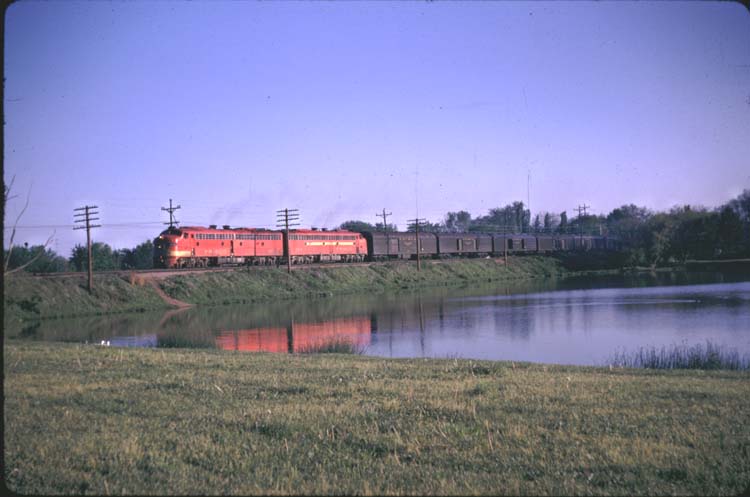 |
Frisco Paint Shop: |
 |
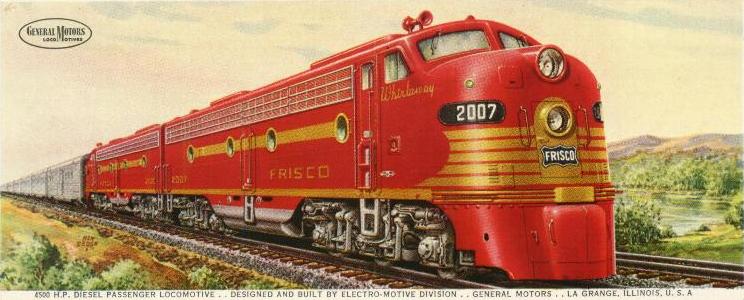 |
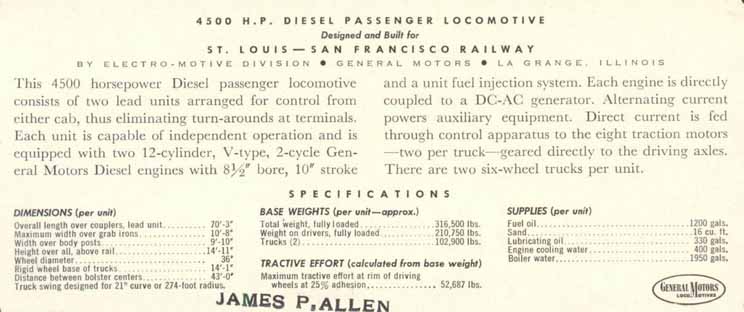 |
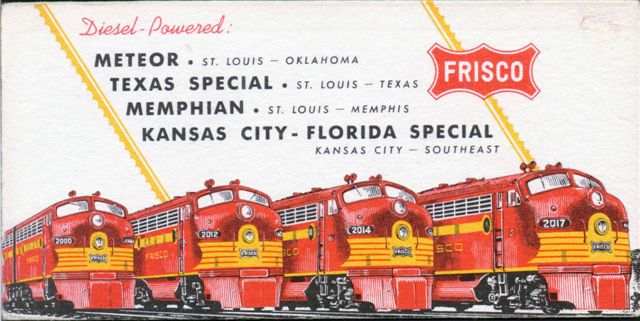 |
From the Phil Gosney Collection. |
| The material that first appeared in FMIG Issue 42 in April 1985 has been updated. |
| Click here for a listing of the names of Frisco E-units. |
| Paint Schemes: FR-P1a: Original E7 paint schemewith stainless steel fluting as applied to those units assigned to the "Texas Special": #2000 and 2003, also MKT #101(101A) and 101B(101C). These units were delivered from EMD in this scheme with "The Texas Special" as the only lettering. This lettering appeared on each corner of the nose and on each side on the top panel between the front two filter panels. Originally these units had no heralds. Within two months, heralds for both participating railroads appeared on the stainless steel plates below the cab, with the owner appearing in front. The Frisco hearld was the "Frisco Lines" coonskin with a bar containing "St. Louis-San Francisco Ry." below. The heralds were stainless steel painted blue with the lettering and connskin outline showing through in stainless steel. The pilot and fuel tank skirts were maroon. Three yellow stripes were applied horizontally to the pilot.The anticlimber was silver with the top rib painted red. The stainless steel plates below the cab, to the height of the stainless steel fluting, curved down to the end of the anticlimber. A silver star appeared on the nose door. Running gear and handrails were silver.The top of the nose, extending to a point at the top of thee nose door and including the upper headlight, was cream colored with the remainder of the body red. See Fig. 1 for an example of the is scheme. Era: date built 3/47-1950. Applied to E7s, SL-SF #2000 and #2003 MKT #101A and #101C. |
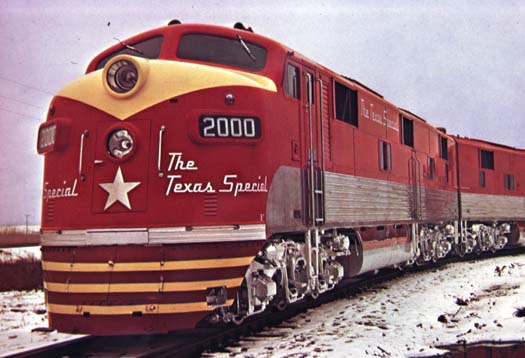 |
(EMD photo, Mike Condren Collection) |
Figure 1a. E7 SLSF #2000 at EMD just before delivery. |
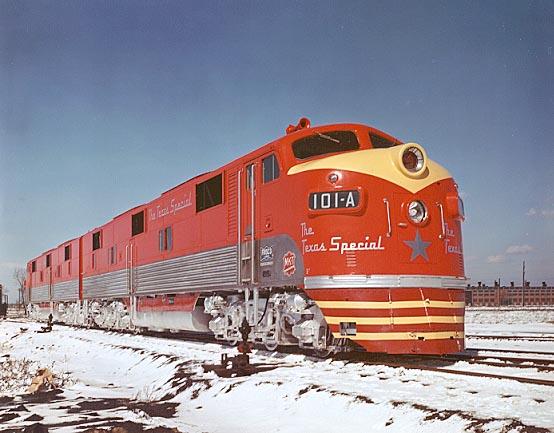 |
| (EMD photo, Mike Condren Collection) |
| Figure 1b. E7 MKT #101A at EMD just before delivery. |
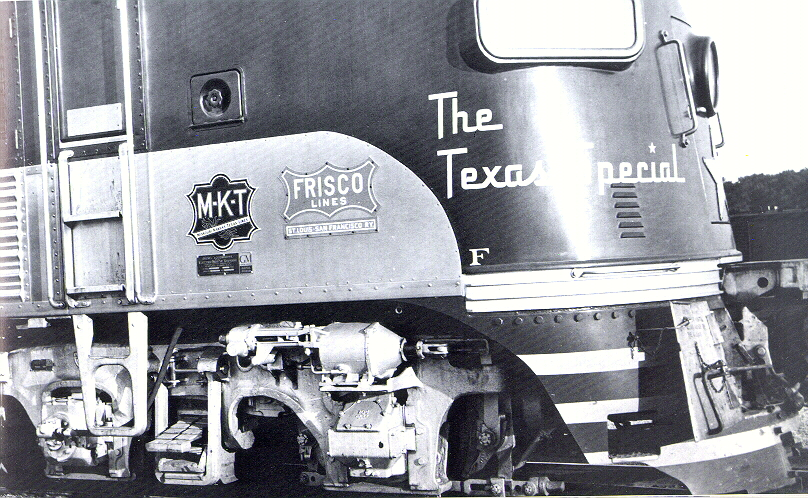 |
| (Mike Condren Collection) |
| Figure 2. Shortly after delivery, heralds were added to the panel under the cab, with owner railroad appearing in front. |
FR-P1b: Original E7 paint schemewith stainless steel fluting as applied to those units assigned to the "Meteor": #2001, #2002, #2004 and #2005. This scheme is nearly idential to "The Texas Special" scheme. The exceptions include "The Texas Special" lettering and MKT heralds.The only lettering is in the form of the SL-SF heralds on the stainless steel plates under the cab and on the nose door. The nose door herald replaced the star of "The Texas Special" scheme. THese heralds were the same as hose used on "The Texas Special" engines.See Fig. 3 for an example of the is scheme. Era: date built 3/47-1950. Applied to E7s, SL-SF #2001, #2002, #2004, and #2005. |
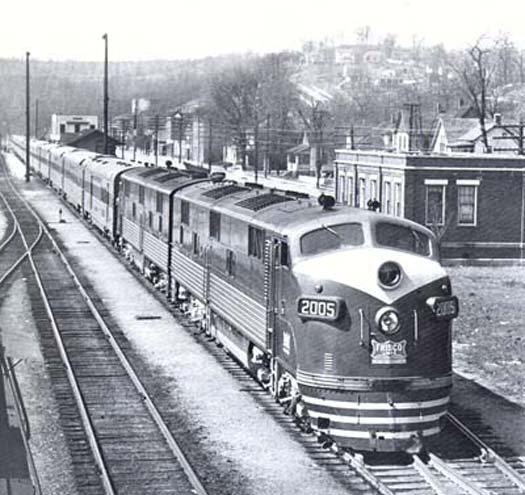 |
(Mike Condren Collection) |
Figure 3. E7 #2005 heads a promotional tour of the new Meteor in the spring of 1948. |
FR-P2a: Gold "cat whiskers" scheme as delivered on the first 10 E8s. This scheme consisted of 5 "cat whisker" type stripes across the nose. The portholes on the sides were outlined and were connected by a gold stripe. The gold lettering consisted of FRISCO on the lower panels behind the cab doors, horse name just below the cab window, and the unit number on the lower panel at the rear of the unit. With this scheme, a dark blue (black) FRISCO herald appeared on the nose door. This scheme may not have been used in revenue service for long if at all but EMD and Frisco photos of the then new E8 plainly show no white outline. However, I have not yet seen a shot of an engine in this scheme coupled to a train. For a very detailed description of this scheme see Mainline Modeler, Oct. 1984. See Fig. 4 for an example of this scheme. Era: 1950. Applied to first 10 E8s delivered: #2006-2015. |
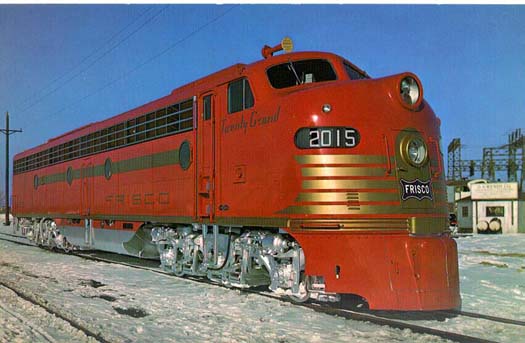 |
(EMD photo, Mike Condren Collection) |
Figure 4. E8 #2015 at EMD before delivery. |
FR-P2b: Modified gold "cat whiskers" scheme. This scheme was like FR-P2a except for the lettering. Yellow Scotchlite lettering consisted of FRISCO on the lower panels behind the cab doors, horse name just below the cab window, and the unit number on the lower panel at the rear of the unit. This scheme to be an attempt to cut costs of repainting by eliminating the white outline of FR-P3 and, thus, probably appeared on units repainted from FR-P3 before scheme FR-P4a was adopted. The change in lettering was apparently due to the sustitution of reflective lettering for the original paint lettering. This is a separate paint scheme as units delivered in FR-P3 appeared fresh in this scheme, an obvious case of repainting. It is not a matter of fading of the white outline as was once thought. Era: late 1950s. Photographically Confirmed Applications: E7: #2000; E8s: #2013, #2014, #2016, and #2019. FR-P3: Gold with white outline "cat whiskers" scheme. Same as FR-P2a except that all stripes and lettering are gold outlined in white. This paint scheme appears to have been applied to all E units, beginning with the last 7 E8s delivered from EMD. After rebuilding the E7s received this scheme. A more detailed description of this scheme appeared in Mainline Modeler, Oct. 1984. See Fig. 5 for an example of this scheme.Era: 1950-1960? Photographically Confirmed Applications: E7s: #2001, #2002, #2003, #2004, and #2005. E8s: #2009. |
 |
(Photo by Louis A. Marre, Mike Condren Collection) |
Figure 5. E7s #2004 and #2003 at Ft. Smith, AR, 8/8/60. |
| FR-P4a: Yellow "cat whiskers" scheme. This scheme was the same as FR-P2a except that all stripes and lettering were yellow instead of gold. This scheme was applied to most if the E-units repainted from scheme FR-P3 but some units appear to have skipped this scheme. See Fig. 6 for an example of this scheme as applied to an E7 and Fig. 7. for an example of this scheme as applied to an E8. Era: 1950?-1965. Photographically Confirmed Applications: E7s: #2000, #2002, #2004, and #2005. E8s: #2007-2015, #2017-2021, and 2nd #2022. |
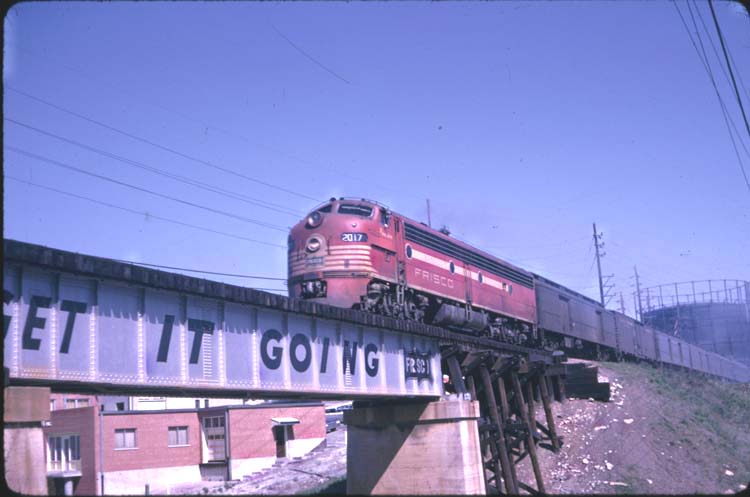 |
(Photo by Mike Condren) |
Figure 7. E8 #2017 on Sunnyland to Memphis at SE Jct. in St. Louis on 5/1/65. |
| FR-P4b: Yellow "cat whiskers" without horse name scheme. This was a somewhat simplified version of FR-P4a with the horse name dropped. Few units received this scheme. Apparently this scheme was a very short-lived simplification that gave way to the "cigar band" scheme on all road units. See Fig. 8 for an example of this scheme. Era: 1964? Photographically Confirmed Applications: E8: #2021. |
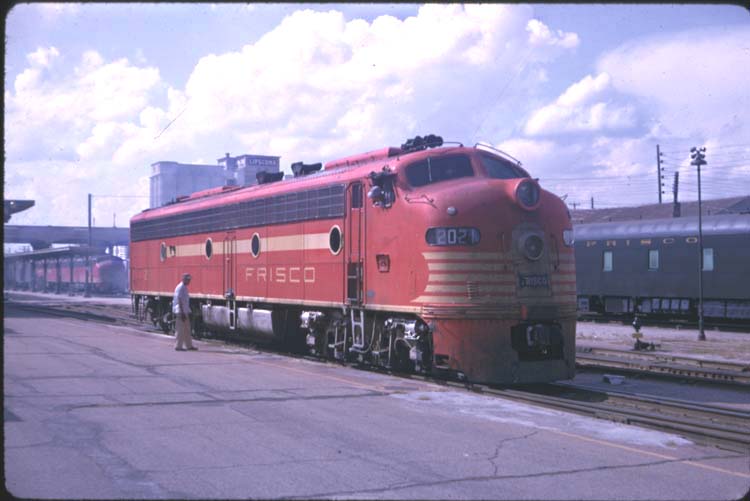 |
(Photo by Mike Condren) |
Figure 8. E8 #2021 preparing to head east on the Will Rogers, Springfield, MO 9/19/65. |
| FR-P5: Gold "cigar band" scheme. This scheme replaced the "cat whiskers with a wide band which extended to the cab ladders. The stripes between the portholes disappeared. Gold Scotchlite patched were added for grade crossing visibility just above the bottom batten on the side. Several units received this scheme. This scheme was an attempt at uniformity in cab-unit paint schemes as it was contemporary with a similar scheme, except for colors, which was being applied to the EMD and ALCO road freight units. See Fig. 9 and 10 for examples of this scheme. Era: 1965-1967. Photographically Confirmed Applications: E7: #2001. E8s: #2006, #2011, #2012, and #2021. |
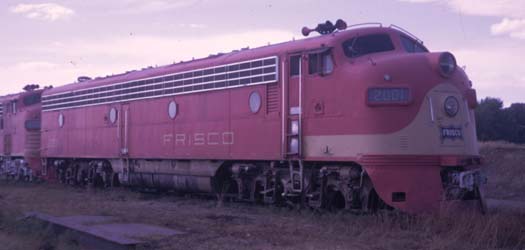 |
(Photo by Mike Condren) |
Figure 9. E7 #2001 stored at Springfield, MO. |
|
(Photo by Mike Condren) |
Figure 10. E8 #2012 pulling the Oklahoman #2 across Frisco Pond in Rolla, MO on an afternoon in April of 1967. |
| FR-P6: Mandarin orange and white scheme. This scheme was the first universal paint scheme. All diesels, switchers, road-switchers, road freight units, and the passenger units were to receive this scheme. It consisted of a Mandarin orange unit with a wide white stripe around the unit, except for the squared-off ends of the cab units. The lettering and numbers were in orange on the white stripe. FRISCO appeared between the front two portholes and the number behind the last porthole. The herald appeared on the nose door as a white outlined coonskin with white FRISCO against the bottom orange stripe. The last #102 from Springfield was powered by 2 E8s, the lead unit in FR-P5 and the trailing unit in FR-P6. See Fig. 11 for an example of his scheme. Era: 1967-1969. Photographically Confirmed Applications: E8s: #2017, #2020, and 2nd #2022. |
 |
(Photo by Mike Condren) |
| Figure 11. E8 #2020 in the last scheme applied to Frisco E-units just before passenger service was discontinued. |
Data from the roster provided by the following sources: Errors in this roster are the sole responsibility of its author. |
